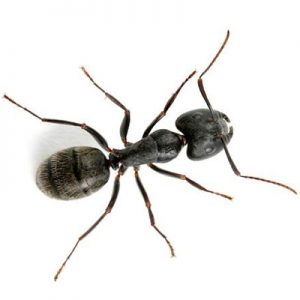Scientific Name: Camponotus spp.
Common Names: Carpenter Ant
Color: Mainly black, but varies from brown and red
Size: Up to 1 inch or 25 millimetres long (workers can be 3 to 13 mm), nearly 5 times the size of a typical pavement ant or black garden ant.
FACT: In North America, lumbermen during the early years in Maine would eat carpenter ants to prevent scurvy.
HABITS
There is only one wingless queen per colony. Colonies contain up to 3,000 workers when maturity is reached in about 3 to 6 years. Swarmers (winged ants) are not produced until the colony is at least 2 years old. The workers forage up to 300 ft from the nest. Carpenter Ants enter buildings around door and window frames, eaves, plumbing as well as utility lines and tree branches that come in contact with the building. Some workers are active during the day, but most activity is from dusk until dawn.
- Feeding: Carpenter ants DO NOT eat wood, they tunnel it out. They instead feed on sources of protein and sugar, including living and dead insects. If inside the home, carpenter ants will feed on pet food and meat, as well as syrup, honey, sugar, and other sweets.
- Hibernation: Carpenter ants hibernate in tight groupings within their nests or in the soil below stumps in the winter. As the temperature drops, levels of glycol build up within the ants cells, allowing them to lay dormant without freezing. The colony will sleep until the warm days of spring.
- Nesting: Most Carpenter Ants establish their first nests in decaying wood and later expand into solid wood. Inside, nests are located in wood (preferably softened by fungus rot), in insulation, and/ or in wall voids. Outside, nests are typically located in rotting fence posts, stumps, firewood, dead portions of standing trees and under stones or fallen logs.
- Reproduction: Winged males and females emerge from established colonies on warm days in the spring and early summer. Mating occurs during a brief flight, after which the male dies, and the female (queen) removes her wings and searches for a suitable nesting site. The nest is usually located in a cavity in the soft, moist, decaying wood of a hollow tree, stump, or log. A new queen lays fifteen to twenty eggs, which produce the first brood of offspring. The whitish, soft-bodied, legless larvae later become the sterile female workers.
CONTROL
The first step is to determine if the ants are merely foraging inside for food or if there is a nest inside. The best indication of an INDOOR NEST is sawdust (FRASS), wood piles containing insect body parts and/or a rustling sound in the walls. Check suspicious areas with a knife blade, a blade will penetrate infested wood very easily. Be sure to inspect crawl spaces, basements and attics. Carpenter Ants have trails they follow throughout a structure and often use electrical wires and pipes.
Once the nest has been located, residual sprays and dust can be used to treat the nest. Dust around all water pipes, under sinks, toilets, dishwashers, etc. Treat around base boards, window frames and door frames with labelled residual insecticide. Outside, be sure tree branches are not touching the building. Wood piles should be off the ground and stored away from the building.
Exterior sprays with a residual insecticide should be performed treating around window frames, door frames, cracks in the foundation and where the soil and foundation meet. Outside, check around buildings for foraging trails, especially in the direction of trees and shrubs, wood piles etc. Spray around foundations and other areas of concern outdoors. Cut trees and shrubs back that come in contact with the building. Caulk around window and door frames and any gaps around electrical and water lines will help to prevent the ant from coming indoors.
Inspect old railway tiles around the building, as often they are the source of infestation. Treat the tiles with insecticide dust or residual sprays.
Our technicians are trained and certified in the latest pest control techniques and provide courteous, professional service to clients all over Western Canada. For an assessment of your pest control needs contact us online or by telephone Toll-Free at 1-888-768-5467.

